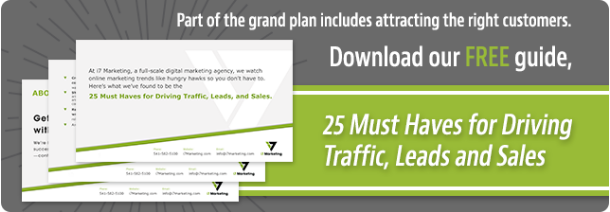
Marketing serves two general goals. The first is to identify the customer. The second is to satisfy the customer. Without a customer you cannot have a profitable business. Marketing is the set of management processes that helps you find and keep customers. The better your marketing, the more sales you can earn.
Yet, marketing also costs money; lots of money. It can range from 5 to over 30 percent of your sales. Not all marketing is profitable. Certain types of marketing costs more and carries a higher risk, whereas other types of marketing may not cost as much but may also vary in the rewards. The key is to focus on the marketing strategies that yield the highest return on investment. This is your marketing ROI.
There are four things that your business needs to focus on to maximize your marketing ROI:
1. Identify Your Target Market
The most vital decision you can make is to identify your target market. Identify as many characteristics as possible, including demographics and psychographics. The more you know about your target market, the easier it will be to find potential customers and compel them to buy from you.
By focusing on a narrow niche of customers that match the characteristics of your target market, you are able to run your marketing campaigns more cost-efficiently. The percent of prospective customers is much higher when you market to a narrow niche as opposed to a broad range of prospects.
Plus, you can have a higher return on investment by focusing your marketing on a narrow niche, than you would if you spread your marketing dollars on a broader target with a lower response rate.
If your target market is too broad, you’ll likely waste money marketing to prospects that are not interested in your products or services. You’ll also risk losing your target because your message may get too general and no longer fit those who would otherwise buy.
For example, a company that sells parts for agricultural vehicles would limit its target audience. It would not spend its resources marketing to the construction or aviation markets.
2. Develop a Relationship with Your Target Market
Once you have clearly identified your target market, you can now devise a strategy to develop a relationship with them. One way to do so is to advertise and promote your products and services where your target customers go. Advertising helps you build awareness of your brand. Nonetheless, it may take multiple impressions before you convert a prospect into a customer.
Making your brand known to your target market is a good first step. To maximize your sales performance, you need to develop a deeper relationship with your target market.
Social media is a great way to develop a relationship with your prospects and customers. You can learn more about their interests, attitudes and values. As you share information about your company, you can gather more facts about your audience. This can help you customize a personalized message when you promote future marketing campaigns both before and after you make your first sale with a customer.
Relationship building does not end with the sale. In fact, this is the time to increase your communication. When you communicate after the sale, you build a deeper relationship. The customer will see you care about them and not just the sale. This is the time to learn about how they like your product and service. You can also learn how they use it, what improvements you can make and what new products and services you can develop.
Think of developing relationships–especially after the sale–as a long-term investment that can yield high returns. That’s because if your customer likes your company, they’ll likely buy more from you and refer others to you.
Barclays Commercial Bank “Turning the Corner” scheme is a great example of developing customer relationships to drive more sales, according to a case study B2BMarketing.net published in 2009. Barclays developed a microsite that provided new and valuable information to its 81,000 business customers each month. The microsite also featured interviews with customers who shared their experiences.
Barclays published a newsletter that it sent to its customers. The newsletter promoted and drove traffic to the microsite and to live events in five cities throughout the United Kingdom. Customers who attended were able to exhibit their products and services.
The results of their relationship building campaign were impressive. Barclays attracted over 1,000 attendees to its events and helped these businesses get 200 business leads. Barclays got 52 qualified leads with a potential income of £703,000. The strategy proved so successful that Barclays planned more relationship building promotions and events. In total, Barclay invested £316,000 which led to a potential income of £1.27 million.
Eduardo Vergara, CEO of Barclays stated,
"The overwhelming feedback from customers and KBI's is that we are the only player in the market proactively hitting the street and engaging customers. With the economic environment as it is, the positive effect of such action should not be underestimated.”
3. Turn Impressions into Dollars
You make an impression each time a prospective customer sees or hears about your brand. Most common is an advertising impression, but you can also create an impression through social media and content marketing.
ROI can also stand for return on impression. To maximize your return on impression, you need to reach not only more eyeballs, but eyeballs that turn into relationships that over time become loyal customers–but it all starts with an impression.
One big thing to think about when developing your marketing strategy is how you can create a favorable perception among your audience. In other words, it’s not enough to create an impression. You need to make that impression create value for your audience. You need to induce an emotional reaction about your brand among each individual on whom you’ve made an impression.
To maximize your return on investment, you also need to be particular with how you deliver your impressions. Don’t just follow what everyone else is doing. You need to find the right types of media to deliver your impression that’s right for your business. Deliver your impressions to your target market and you’ll yield a higher ROI.
The way to turn impressions into dollars is to engage your audience members with each impression. Empathize with their pain. Show them you have a relevant solution. Lead them from interest to purchase. It’s a process that starts with introducing your brand to developing a loyal customer.
4. Increase the Lifetime Value of Customers
Each customer has a lifetime value. That is the amount of money you can expect to earn from this customer for the entire lifetime of their relationship with your brand. Customer lifetime value is vital for your company to achieve and sustain a distinct competitive advantage. It is essential that you understand how various interconnected factors influence customer lifetime value and work towards increasing it.
To maximize your marketing ROI, focus on prospects and customers that can yield the highest lifetime value. There are three main factors to consider.
The first and most important thing to focus on is your acquisition cost. How much does it cost you to turn a prospect into a customer? This is why identifying a target market is so important. The lower your acquisition cost, the more money you can make. Plus it leaves you more cash in your marketing budget to apply to other campaigns.
The second factor to consider is your retention rate. Repeat customers are what you want. The better you can address their needs, the more likely your customers will buy from you again. The more frequently your customers buy from you, the higher the customer value is to your company.
The third factor is the dollar volume. How much money your customers spend on your products and customers also affects their customer value to your company. The more you earn each year from a customer, the higher their value is to your company.
Look to maximize customer share to help you maximize your marketing ROI. Customer share is the percent of dollars the customer spends on your products and services compared with what they spend in total for products and services in your industry. The higher the customer share, the greater value this customer is to your company.
A lifetime value case study of Netflix in 2012 shows why it’s vital to know the lifetime value of your customers. Based on its lifetime value metric Netflix learned its average subscriber lasts for 25 months and brings in over $291. By knowing this, Netflix is able to determine how much they can invest in getting a new customer, knowing the difference is their profit.
At the time of this study Netflix charged subscribers $11.65 per month or $139.80 per year. If Netflix invested $150 in customer acquisition it would not make money until year two. By knowing the lifetime value of each new customer, Netflix knows their expected profit.
Plus, it spurs them on to develop ways to increase the lifetime of each customer. One way is to customize their communication to each subscriber. This requires building a relationship, learning more about each customer’s interests, and providing a personalized solution. As it turns out, Netflix did this and added streaming movies to its services. This strategy reduced its customer churn and increased its lifetime value.
Next Steps
Put these four steps to use for your business. Identify your target market. Develop a relationship with the customers. Turn impressions into dollars. Increase the lifetime value of your customers. By doing these things will see your company grow and earn more.



Submit a Comment
Your email address will not be published. Required fields are marked *